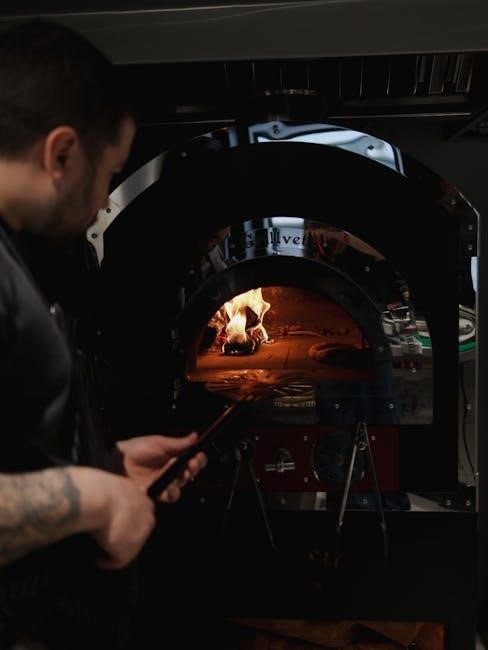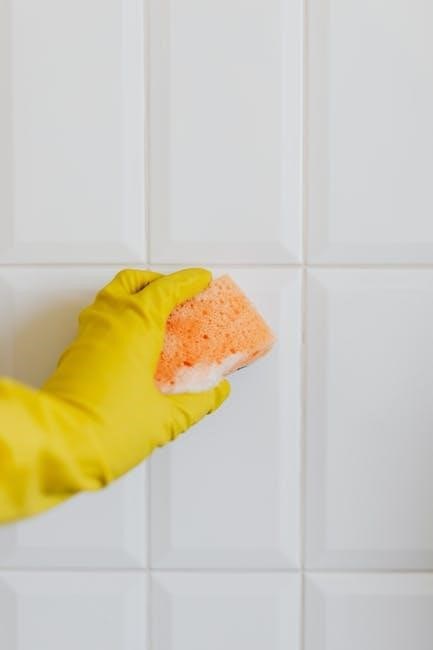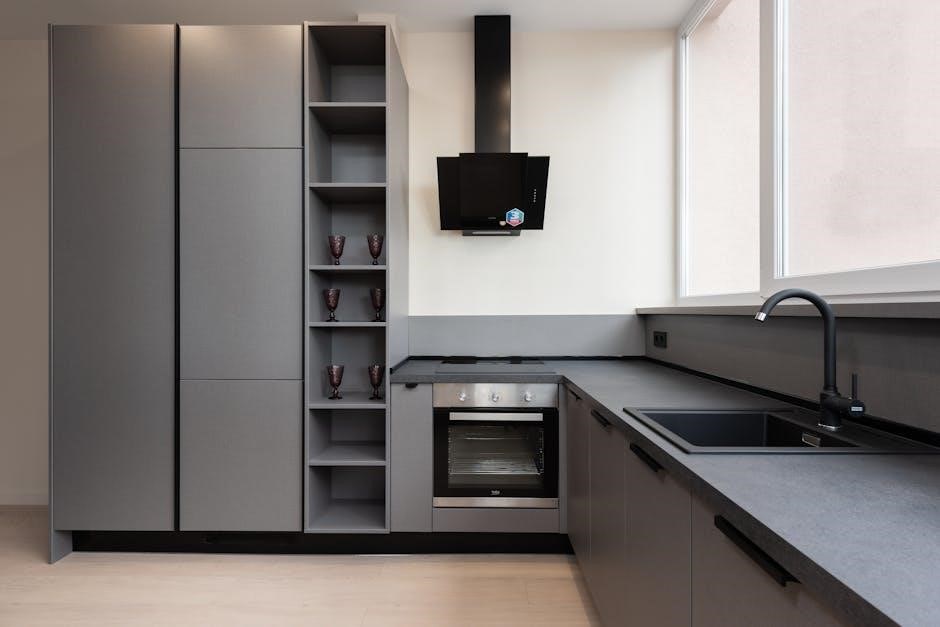The self-cleaning feature of GE ovens simplifies maintenance by using high temperatures to burn food residue, leaving a light ash that’s easy to wipe away. This function enhances efficiency and reduces cleaning effort, but proper usage is essential for safety and optimal performance. Always follow the owner’s manual guidelines to ensure effective and secure operation.
Safety Instructions
Always follow safety guidelines when using your GE self-cleaning oven. Keep the oven door closed during the cleaning cycle and avoid forcing the latch, as this can damage the lock mechanism. Ensure proper ventilation, as high temperatures may release fumes. Never use abrasive cleaners, and adhere to the manual’s instructions for safe operation.
Preparing the Oven for Self-Cleaning
Before activating the self-cleaning feature on your GE oven, proper preparation is essential to ensure safety and effectiveness. Start by removing all racks, shelves, and utensils from the oven cavity, as these can obstruct the cleaning process or damage the oven. Wipe up any heavy food residue on the oven floor using a damp cloth or paper towels to prevent excessive smoke during the cycle.
Next, clean the oven gasket by gently wiping it with a mild soap solution. Avoid using abrasive cleaners or scrubbers, as they may damage the gasket. Ensure the oven is completely empty, including any food particles or debris, to allow the self-cleaning cycle to work efficiently. If your oven has a latch release button, familiarize yourself with its operation before starting the cycle.
Protect your kitchen floor and surrounding areas from potential ash or residue by placing a large drop cloth or old towels around the oven. Finally, ensure all controls are set correctly, and the oven door is securely closed before initiating the self-cleaning process. Proper preparation ensures a safe and effective cleaning experience for your GE self-cleaning oven.
Remember, the self-cleaning feature uses high temperatures, so it’s crucial to follow all safety guidelines outlined in your owner’s manual. Avoid running the cycle before major events, as unexpected issues may arise. Always ventilate your kitchen well to minimize exposure to fumes during the cleaning process.
Safety Precautions During the Cleaning Cycle
When using the self-cleaning feature on your GE oven, it’s crucial to follow safety precautions to avoid accidents and ensure a smooth cleaning process. The self-cleaning cycle operates at extremely high temperatures, which can release fumes and potentially harmful gases, including carbon monoxide. To minimize exposure, ensure your kitchen is well-ventilated by opening windows and turning on exhaust fans.
Avoid using abrasive cleaners or scrubbers during or after the cycle, as they can damage the oven’s interior or gasket. Never force the oven door open during the cleaning cycle, as this can damage the door lock mechanism. The oven door will automatically unlock once the cycle is complete and the interior has cooled down sufficiently.
Keep children and pets away from the oven during the self-cleaning process, as the exterior surfaces will become extremely hot. Do not leave the kitchen unattended while the cycle is running, as prolonged high temperatures can pose a fire hazard. If you notice unusual smells or excessive smoke, turn off the oven and ventilate the area immediately.
The self-cleaning cycle can take several hours to complete, depending on the level of soil inside the oven. Be patient and allow the oven to cool completely before wiping away the ash with a damp cloth. Always follow the safety guidelines outlined in your GE oven’s owner’s manual to ensure a safe and effective cleaning experience.
Post-Cleaning Safety Measures
After the self-cleaning cycle is complete, it’s essential to take several safety precautions to ensure your GE oven is safe to use and maintain. First, allow the oven to cool completely before attempting any cleaning or inspection. The interior and exterior surfaces will remain extremely hot for several hours, so avoid touching them to prevent burns.
Once the oven has cooled, open the window and ensure good ventilation in the kitchen to eliminate any lingering fumes. Use a damp cloth to wipe away the ash and residue, but avoid using abrasive cleaners or scrubbers, as they can damage the oven’s finish or gasket. For tougher spots, a mild soap solution can be used, but always rinse thoroughly to remove any cleaning agent residue.
Inspect the oven for any signs of damage, such as cracks or discoloration, after the self-cleaning cycle. If you notice any issues, consult a professional before using the oven again. Additionally, check the door lock mechanism to ensure it is functioning properly, as the high temperatures may have affected its alignment or operation.
Never leave the oven unattended during the cooling process, especially if there are children or pets in the household. Keep the oven door closed until it has fully cooled to prevent accidental burns or injuries. By following these post-cleaning safety measures, you can ensure a safe and effective maintenance routine for your GE self-cleaning oven.

Operating the Self-Cleaning Feature
Operating the self-cleaning feature involves closing the oven door, setting controls correctly, and engaging the lock mechanism. The oven uses high temperatures to burn food residue. Always ensure the door is sealed and follow the manual’s specific instructions for your model to ensure safe and effective cleaning.
Step-by-Step Activation Process

Activating the self-cleaning feature on your GE oven involves a straightforward process. First, ensure the oven is empty of racks, pans, and food debris. Preheat the oven to a low temperature to loosen tough residue; Next, locate the self-clean button or knob, depending on your model, and select the self-clean option. Choose the recommended cleaning cycle duration, typically 2-4 hours, using the control panel. Close the oven door firmly and ensure the door lock mechanism engages securely. For models with a latch release button, press and hold it while sliding it into the clean position. Once activated, the oven will heat to a high temperature, burning food residue into ash. Do not open the door during the cycle. After the cycle completes, allow the oven to cool completely before wiping away the ash with a damp cloth. Always refer to your specific owner’s manual for model-specific instructions, as activation steps may vary slightly. Proper activation ensures safe and effective cleaning, maintaining your oven’s performance and longevity.
Understanding Different Cleaning Cycles
GE self-cleaning ovens offer various cleaning cycles tailored to different levels of soil buildup, ensuring efficient and customized maintenance. The most common cycles include light, medium, and heavy-duty options. The light cycle is ideal for minor food spills and splatters, requiring a shorter duration of about 1-2 hours. For more general cleaning needs, the medium cycle is recommended, typically lasting 2-3 hours. The heavy-duty cycle is designed for tough, baked-on residue and runs for 3-4 hours, utilizing the oven’s maximum temperature to thoroughly burn away grime.
Some models also feature an eco-friendly or energy-saving cycle, which operates at a slightly lower temperature but over a longer period to minimize energy consumption. Additionally, certain high-end models may include a steam cleaning option for lighter messes, combining heat and moisture to loosen debris without extreme temperatures. Regardless of the cycle chosen, the oven door will automatically lock once the cycle starts to ensure safety and proper function.

It’s important to select the appropriate cycle based on the level of cleaning required, as this optimizes both efficiency and results. Always refer to your specific owner’s manual for detailed cycle descriptions and recommendations tailored to your oven model. Proper cycle selection ensures effective cleaning while maintaining the oven’s performance and longevity.
The Role of the Door Lock Mechanism
The door lock mechanism is a critical safety feature in GE self-cleaning ovens, ensuring safe operation during the cleaning cycle. This mechanism automatically engages when the self-cleaning cycle is activated, securely locking the oven door to prevent accidental opening while high temperatures are in use. The lock remains engaged throughout the cycle and only releases once the oven has cooled down sufficiently, minimizing the risk of burns or exposure to harmful fumes.
The door lock also ensures the integrity of the cleaning process by maintaining a tight seal, which allows the oven to reach and sustain the extreme temperatures necessary for effective cleaning. This seal prevents heat and smoke from escaping, optimizing the burning of food residue. Forcing the latch or attempting to open the door during the cycle can damage the mechanism, so it’s essential to wait until the cycle completes and the oven cools down naturally.
Some models, such as the GE Profile series, feature an advanced door lock system with a latch release button for added convenience. However, the core function remains the same: to prioritize safety and efficiency during the self-cleaning process. Always adhere to the owner’s manual guidelines to ensure proper function and longevity of the door lock mechanism. This feature is a key component of the oven’s design, enhancing both safety and performance during self-cleaning operations.
Maintenance and Upkeep
Regular maintenance ensures optimal performance of your GE self-cleaning oven. Clean the exterior with mild soap and water, avoiding abrasive cleaners. Wipe up heavy soil before the self-cleaning cycle for better results. Check the oven gasket for wear and tear to maintain a proper seal during operation.
Recommended Cleaning Frequency
The frequency of cleaning your GE self-cleaning oven depends on usage. For light use, running the self-cleaning cycle every 1-2 months is sufficient. For heavier use, such as frequent cooking or baking, it is recommended to clean every 1-3 months. Always wipe up heavy food residue before starting the cycle to ensure optimal results. Light soil can be handled by the self-cleaning feature, but excessive buildup may require more frequent cleaning. Avoid using the self-cleaning function too often, as it can wear down the oven’s interior over time. Instead, maintain the oven by wiping it down after each use with a damp cloth to prevent grime accumulation. For tougher stains, a mild soap solution can be used, but avoid harsh chemicals or abrasive cleaners, as they may damage the finish or harm the self-cleaning lining. Regular maintenance ensures the oven remains efficient and prolongs its lifespan. Additionally, inspect the oven gasket periodically to ensure a proper seal, which is crucial for safe and effective cleaning cycles. By following these guidelines, you can keep your GE self-cleaning oven in excellent condition and ensure it continues to perform reliably for years to come.
Care and Maintenance of the Oven Gasket
The oven gasket is a critical component of your GE self-cleaning oven, ensuring a proper seal during the cleaning cycle. To maintain its integrity, avoid cleaning the gasket with harsh chemicals, abrasive cleaners, or rough scrubbers, as this can damage the material. Instead, gently wipe it with a soft cloth dampened with mild soap and water. Never remove the gasket, as this can cause misalignment or damage to the door lock mechanism. Inspect the gasket regularly for signs of wear, such as cracks, tears, or a loose fit. If damage is detected, replace the gasket immediately to prevent heat from escaping during the self-cleaning cycle, which could lead to inefficient cleaning or safety hazards. Additionally, avoid exposing the gasket to excessive heat when not in use, as prolonged high temperatures can degrade the material over time. For specific maintenance instructions, refer to your GE oven’s owner’s manual, as recommendations may vary slightly depending on the model. Proper care of the gasket ensures optimal performance, safety, and longevity of your self-cleaning oven.

Troubleshooting Common Issues
Like any appliance, your GE self-cleaning oven may encounter issues that require attention. One common problem is the oven not turning on after a self-cleaning cycle. This could be due to a faulty door lock mechanism or an error in the control settings. Ensure the door is fully closed and latched correctly before starting the cycle. If the issue persists, check for error codes on the display and refer to your owner’s manual for troubleshooting steps.
Another frequent concern is the oven emitting a strong odor or smoke during the self-cleaning process. This is typically caused by excessive food residue burning off. To minimize this, clean up large spills before running the cycle and ensure proper ventilation by opening windows or turning on your kitchen exhaust fan. Additionally, avoid interrupting the cycle once it has started, as this can lead to incomplete cleaning and potential damage to the oven’s components.
If the self-cleaning feature fails to activate, verify that all controls are set correctly and the oven is in the proper mode. Some models may require specific button combinations or sequences to initiate the cycle. If the problem continues, consult the troubleshooting section of your manual or contact a certified GE technician for assistance. Regular maintenance and adherence to safety guidelines can help prevent many of these issues and ensure your oven operates efficiently for years to come.

Specific Models
GE offers various self-cleaning oven models, including Coil Top and Radiant Top designs. Coil Top models feature exposed heating elements, while Radiant Top models use a smooth surface for even heat distribution. Each model has unique features and maintenance requirements, so always refer to your specific owner’s manual for detailed instructions.
Coil Top Models
GE Coil Top models are known for their durability and straightforward design, featuring exposed heating elements that provide consistent heat distribution. These models are popular for their reliability and ease of use, especially when utilizing the self-cleaning feature. To activate the self-cleaning cycle on a Coil Top model, ensure the oven door is closed and all controls are set correctly. The self-cleaning process uses high temperatures to burn food residue, leaving a light ash that can be easily wiped away after the cycle completes.
For Coil Top models, it’s important to follow specific safety guidelines. Avoid forcing the door latch, as this can damage the locking mechanism. Additionally, the oven should be well-ventilated during the cleaning cycle to prevent the buildup of harmful fumes. After the cycle, allow the oven to cool before wiping down the interior with a damp cloth. The fiberglass insulation in these models may release small amounts of carbon monoxide during cleaning, so proper ventilation is crucial.
Regular maintenance for Coil Top models includes cleaning the exterior and ensuring the heating elements are free from debris. Refer to your owner’s manual for model-specific instructions, as some features may vary. By following these guidelines, you can maintain your GE Coil Top oven’s performance and extend its lifespan.
Radiant Top Models
GE Radiant Top models are designed with a smooth glass surface and hidden heating elements, offering a modern and sleek appearance. These models are ideal for users who prefer a low-maintenance cooking surface. When using the self-cleaning feature on Radiant Top models, it’s essential to follow specific guidelines to ensure safety and effectiveness. The self-cleaning cycle uses high temperatures to burn food residue, but the process must be initiated correctly.
Before starting the self-cleaning cycle, ensure the oven door is closed and all controls are properly set. Avoid forcing the door latch, as this can damage the locking mechanism. During the cycle, the oven may emit fumes, so proper ventilation is crucial. After the cycle, allow the oven to cool completely before wiping away the ash with a damp cloth; For Radiant Top models, avoid using abrasive cleaners on the glass surface, as they can cause scratches. Instead, use a gentle cleaning solution recommended by GE.
Regular maintenance for Radiant Top models includes cleaning the glass surface and ensuring the heating elements are free from debris. Refer to your owner’s manual for specific instructions, as some models may have unique features. By adhering to these guidelines, you can maintain your GE Radiant Top oven’s performance and extend its lifespan.
Eco-Friendliness and Energy Efficiency
GE self-cleaning ovens are designed with eco-friendliness and energy efficiency in mind, offering a sustainable solution for kitchen maintenance. The self-cleaning feature uses high temperatures to burn food residue, reducing the need for harsh chemical cleaners. This not only minimizes environmental impact but also promotes a healthier home environment by eliminating strong fumes associated with traditional cleaning products.

Energy efficiency is a key focus in GE ovens, with advanced insulation and heating elements that optimize energy use during both cooking and cleaning cycles. The self-cleaning process, while requiring high heat, is designed to be energy-efficient by focusing heat directly on the interior, reducing wasted energy. Additionally, the oven’s insulation helps retain heat, lowering overall energy consumption during operation.
GE also incorporates features like the EcoCycle, which uses lower energy settings to clean lighter soil, further enhancing energy efficiency. Proper maintenance, such as cleaning the oven gasket and ensuring the door seal is tight, can also improve energy performance. By using the self-cleaning feature responsibly and adhering to recommended cycles, users can enjoy a cleaner oven while supporting environmental sustainability and reducing energy costs.
Overall, GE self-cleaning ovens balance convenience with eco-conscious design, making them a practical choice for homeowners who value both efficiency and environmental responsibility.

User Experiences and Reviews
Users of GE self-cleaning ovens often praise the convenience and effectiveness of the self-cleaning feature, which simplifies oven maintenance. Many appreciate how the high temperatures burn food residue into ash, making cleanup easier. However, some users note that the process can take several hours and may produce strong odors or fumes, requiring good ventilation.
Positive reviews highlight the time-saving aspect of not having to manually scrub the oven. Others mention that the feature works best for light to moderate soil, while heavy buildup may require additional cleaning. A few users have reported issues with the door lock mechanism, emphasizing the importance of following safety guidelines to avoid damage.
Some owners recommend using the self-cleaning feature sparingly to avoid wear and tear on the oven’s interior. Additionally, users suggest wiping up heavy soil before starting the cycle for better results. Overall, the GE self-cleaning oven is well-regarded for its performance, but users advise caution and adherence to the manual’s instructions for optimal use.

Online forums and reviews also provide tips, such as using mild soap solutions for post-cycle cleaning and ensuring the oven is properly prepared before activation. These shared experiences help first-time users navigate the process more effectively.

The GE self-cleaning oven is a convenient and efficient appliance designed to simplify oven maintenance. By following the guidelines outlined in the owner’s manual, users can safely and effectively utilize the self-cleaning feature to keep their oven in optimal condition. Proper preparation, such as removing racks and wiping up heavy soil, ensures the best results. While the self-cleaning cycle can take several hours and may produce strong odors, the end result is a clean oven with minimal effort.
It’s important to adhere to safety instructions, such as keeping the oven door closed during the cycle and ensuring good ventilation. Users should also be mindful of the door lock mechanism, as forcing it can cause damage. Regular maintenance, including cleaning the gasket and checking for wear, will extend the oven’s lifespan. Overall, the GE self-cleaning oven is a valuable kitchen tool when used correctly, offering both convenience and effectiveness.
By understanding and following the manual’s instructions, users can enjoy a hassle-free cleaning experience while maintaining their oven’s performance and safety. Always refer to the specific model’s guidelines for tailored advice, as procedures may vary slightly between different GE oven models.
